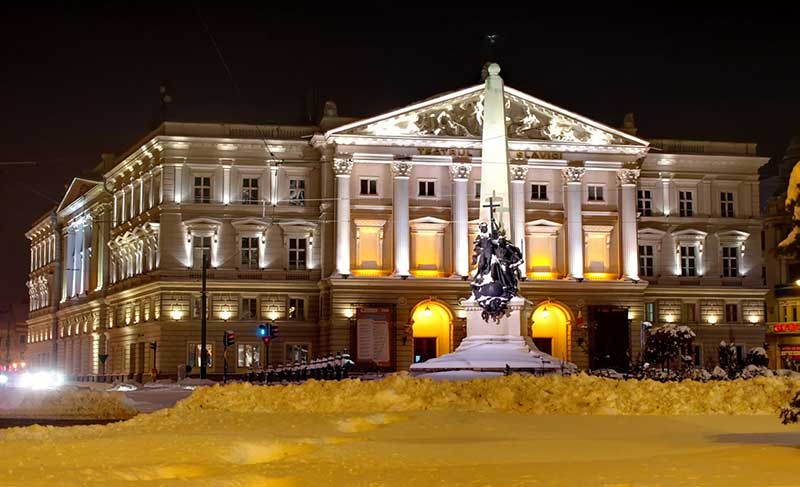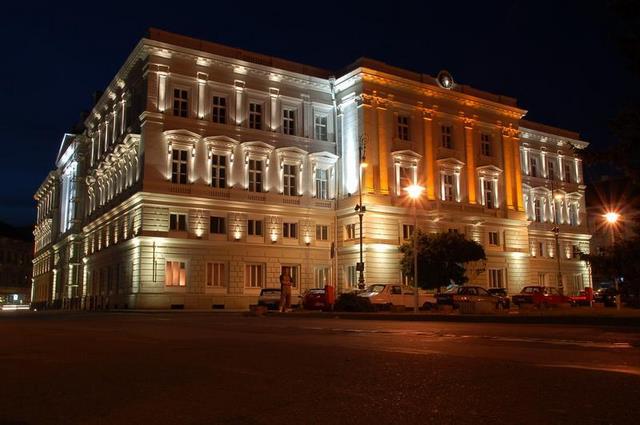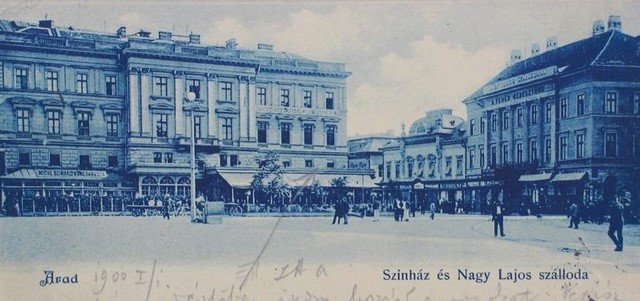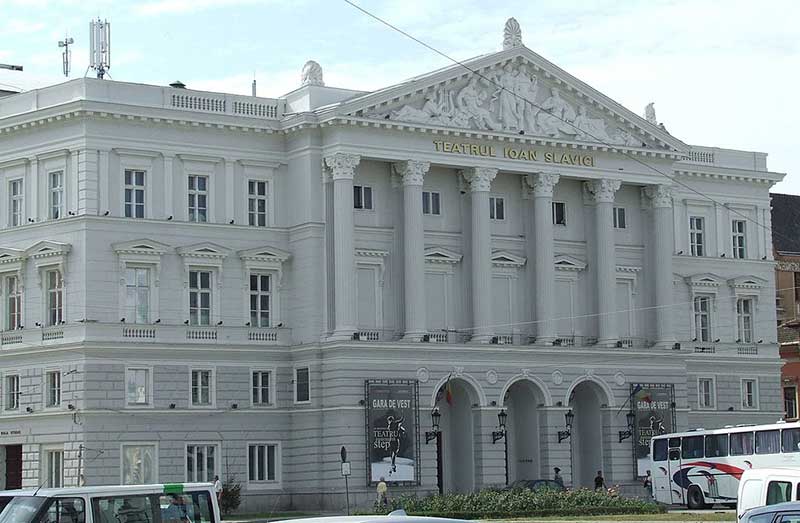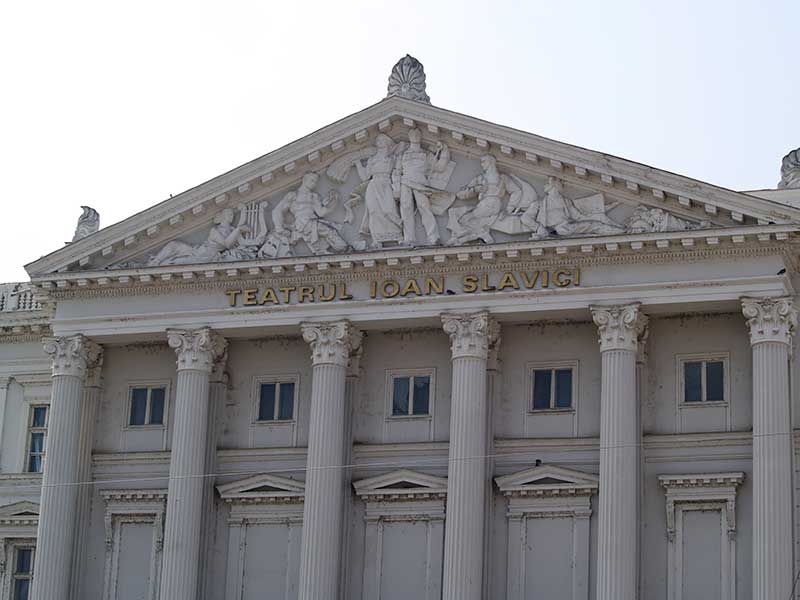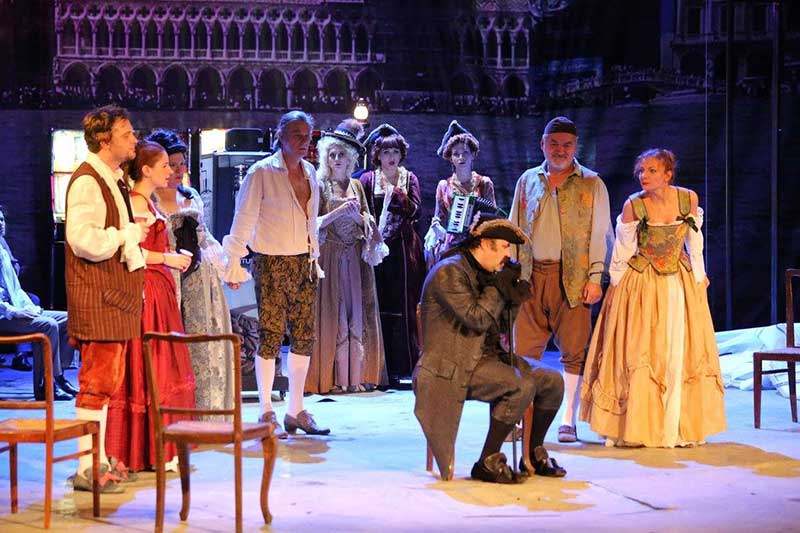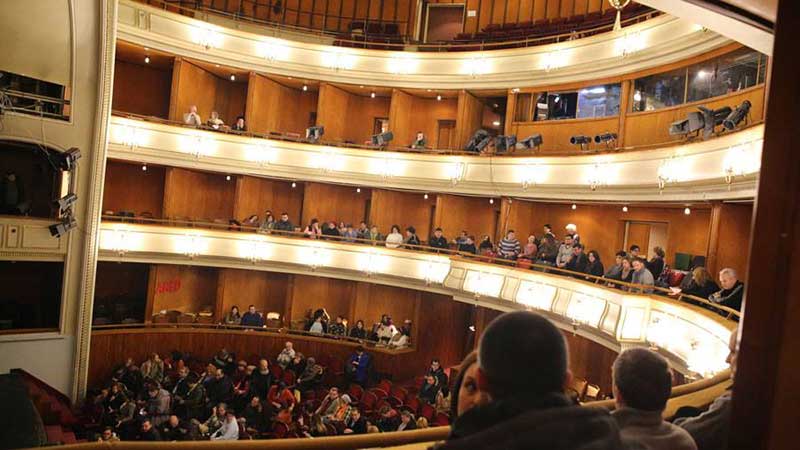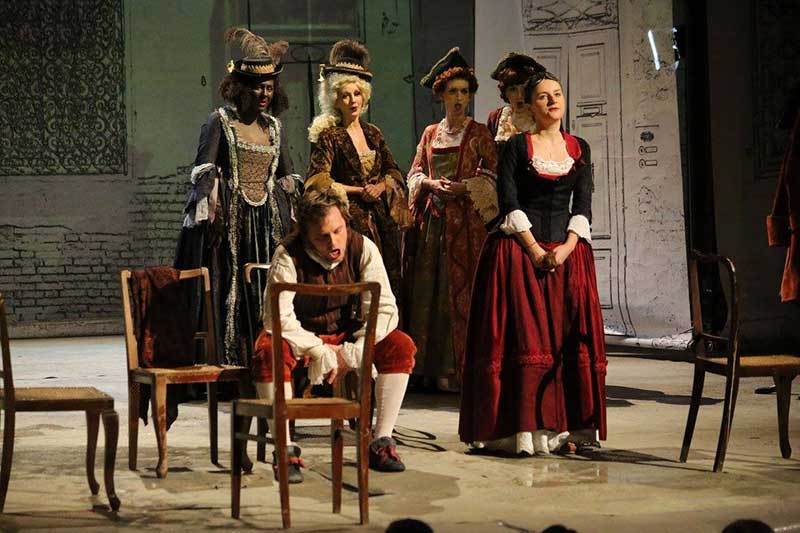Ioan Slavici Classical Theatre – Summary
The Ioan Slavici Classical Theatre (Teatrul Clasic Ioan Slavici) is a three-story, nineteenth century, neoclassical theatre located in the city of Arad. The building was named after one of Romania’s most renowned writers, journalist, and Arad native, Ioan Slavici. The theatre has put on thousands of shows throughout the decades that have delighted and dazzled guests from both near, and afar.
The theatre’s inception took place in 1868 when Arad’s city mayor, Aztel Peter, and the baron, Béla Bánhidy, along with other city officials, decided that the city had to have a new theater. After the decision was made they moved forward and replaced Arad’s old and outdated baroque style theater, which had been functioning as the city’s primary theater since 1817, with the new Ioan Slavici Classical Theatre.
The first show that was performed in the theater was a prologue of Karoly Szasz. The second was a comedic play called The Hunt. Both shows were performed by the Budapest National Theater on September, 21st, 1874. Some of the guests who attended those first two plays were spectacles in and of themselves.
The guests included some of the most powerful and influential persons of the era. Among the initial 1,000 or so attendees were, Franz Josef (the Emperor of Austria and King of Hungary), and Prince Albrecht (son of Duke Friedrich). Various other guests were princes, princesses, aristocrats, influential people, and other royalty of the day.
Ioan Slavici Classical Theatre – Table of Contents
- Ioan Slavici Classical Theatre – History
- Ioan Slavici Classical Theatre – Architecture
- Ioan Slavici Classical Theatre – Present Day
- Ioan Slavici Classical Theatre – Video
- Ioan Slavici Classical Theatre – Visitor Info
Ioan Slavici Classical Theatre – History
The Ioan Slavici Classical Theatre that is found in present-day Arad is noticeably different from the original 1800s version. The theatre suffered two devastating fires in its history and had to have certain portions rebuilt from scratch. What stands today is an altered version that contains as many salvaged portions from the original as possible.
The Original Theater
The original theater was an impressive sight of its day. It was a three-story masterpiece designed with the intention to host some of the region’s best talents. The ground floor contained a massive hall with a grand stage. No detail was left unturned in the hall’s design. Some of the best craftsman and artists from Arad, as well as from Budapest, and Vienna, meticulously fashioned and created it.
The hall room was magnificently lit up by a marvelous 36 arm gas-lit chandelier. The chandelier was modeled after and resembled the splendidly crafted and beautifully sculpted chandelier of Vienna’s Opera House. The Ioan Slavici theater’s chandelier produced warm mellow lighting in the hall which blended well with the overall relaxed ambiance felt inside the theater.
The first and second floor of the theater contained a total of 92 beautifully decorated loggias which were designed with the specific intent of hosting some of the day’s most influential and important people. The loggias wrapped around the hall in a U shape and provided exceptional visibility of the stage.
The third floor consisted of a balcony and a gallery. The balcony seating arrangement was designed and fitted similar to the ground floor. The theatre’s gallery was the highest point which had seating available. The cheapest tickets which could be purchased were for seats in the gallery section of the theatre.
The theater’s total capacity for an audience was 1,200. The capacity for the lower level was 426, of which 276 were seated spots, and 150 were standing spots at the back of the room. Flours two and three were able to accommodate 532 persons in the loggias. And the third flour held 242 seats, 72 in the balcony, and 170 in the gallery.
Fire in a Theater
Like other great works of art or stunningly constructed buildings, theaters are not immune to disasters or devastation. Sometimes part of what makes something great is the part that ends up bringing on the downfall of its possessor. Such is the story of the two fires that engulfed and almost destroyed the Ioan Slavici Classical theater.
The First Fire
The first fire to take a devastating toll on the theater happened on February, 18th, 1883. At the point in time when the first fire took place, the theater had been open and functioning for 9 years. The cause of the fire was a malfunction in the hall’s gas-lit chandelier. Great priority had not been placed on the routine safety checks of the building’s infrastructure. Had frequent routine maintenance been done, the malfunction that sparked the fire would have been easily discovered and quickly repaired.
After the first fire, city officials decided the damage wasn’t severe enough to merit demolishing the building. They felt that reconstruction efforts would be justified and that the builders should salvage and preserve as much of the original version as possible. The officials hired the Hungarian, Arad local, and renowned architect, Andor Halmay, to design blueprints for the parts of the building that needed reconstruction.
Rebuilding efforts lasted two years and saw the theater receive new modifications and upgrades. The lighting was changed from gas to electric, seating arrangements were changed and made more accessible, and an 80-ton iron curtain was added to be drawn across the stage during intermissions. The theater had its grand reopening in 1885. The first show which played in the newly modified theater was a play done by the famous dramatist, and Arad native, Gergely Csiky.
The Second Fire
Sometime in 1957, a second fire started from an unknown source and again did great damage to the then fully restored building. The officials of Arad once again decided to allocate funds to salvage and restore the theatre. The second restoration of the theater caused it to endure more internal and external changes than the first restoration, including slight changes to the original shape of the building.
After the second fire, reconstruction of the theatre was carried out by a joint effort from, chief architect, Professor Alexandru Iotzu, a theatre design specialist from Bucharest, and architect, Miloș Cristea, an Arad native. The architectural duo designed the new building to serve the purpose of theatre only, not a mixed establishment building (shops, restaurants) as it had served previously.
Similar to efforts after the first fire, the second rebuilding was carried out using as many materials from the original site as could possibly be recovered. The hall of the building was reconstructed using mainly concrete in efforts to make it more resistant and durable in case of future natural disasters. The theatre’s stage didn’t require much restoration because it was spared from severe damage by the massive iron curtain that was added to it after the first fire.
The upgrades and changes which were done to the theatre after the second fire were more numerous, as well as more significant, than the ones done during the first. The building’s main entrance was changed to the side of the building away from the main road. The actor’s rooms, production workshops, library, gym, rehearsal rooms, and prop storage sets were all updated and modernized.
The theatre was reopened for the second time in 1960. Even though much of the original designs, both interiorly and exteriorly, were preserved, the new changes, upgrades, and modifications that were done transformed its original look from a classical theatre to being the country’s most modern and elaborate theatre.
Ioan Slavici Classical Theatre – Architecture
The Ioan Slavici Classical Theatre was designed by two separate architects. The architect who designed the interior portion of the building was Gyorgy Bako, the theater’s exterior was designed by an architect known as Skalniczky of Pesta. The two architects for the project were chosen because of their unique ability to envelope the neoclassical architectural style, which was the style desired by city officials for the building. Construction of the theater took two years for completion (1872 to 1874) and was carried out by town locals.
The construction project for the theatre coincided with the development of the Administrative Palace of Arad, which was being erected at the same time to serve as the town’s city hall. Both of the new buildings were built in order to modernize the rapidly developing city of Arad. To help fund both buildings city officials took out a loan of 700,000 florins from an Austrian bank.
Ioan Slavici Classical Theatre – Present Day
Despite the fiery tragedies that twice brought the theater to its knees, the story of the Ioan Slavici Classical Theatre is one of persistence, dedication, and improvement in the face of adversity. Its story teaches us that when unfortunate incidents occur, the best thing to do is not give up, but to rebuild and come back better and stronger.
Even though the Ioan Slavici Classical Theatre in present-day Arad is different than the one which stood in the 1800s, one thing is still the same, it still provides amazing shows and entertainment for all its guests. The building’s seating has shrunk in size from its original 1,200 available seats. The theatre now has a maximum capacity of 500. Its current interior design reflects tastes of the fifties. Its present-day version is still a marvelous and amazingly beautiful experience to behold in person.
The sound quality inside is impeccable due to the very good antiphonic walls. The visibility of the stage is good from virtually every seat in the building. Seating decisions should be made based on personal preferences. The Ioan Slavice Classical theatre is a must visit for all history and theatre lovers. The theatre puts on many unique, captivating, and highly entertaining shows throughout the year. Because of the diverse types of performances done at the theatre, chances are there is something for everyone.
Ioan Slavici Classical Theatre – Video
Ioan Slavici Classical Theatre – Visitor Information
Location
The Ioan Slavici Classical Theatre is located in the city of Arad’s city center at the address: Bulevardul Revoluției 103. It is right in front of the Avram Iancu square (Piața Avram Iancu), and directly behind Hotel Ardealul.
Visitation
The Theatre’s hours are:
| Monday | Closed |
| Tuesday | 7:00 – 9:00 pm |
| Wednesday | Closed |
| Thr–Sun | 7:00 – 9:00 pm |
Ioan Slavici Classical Theatre – Resources
Official Site
Official Facebook
Official YouTube
Official Instagram
